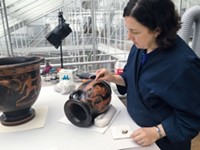Advertisement
Grab your lab coat. Let's get started
Welcome!
Welcome!
Create an account below to get 6 C&EN articles per month, receive newsletters and more - all free.
It seems this is your first time logging in online. Please enter the following information to continue.
As an ACS member you automatically get access to this site. All we need is few more details to create your reading experience.
Not you? Sign in with a different account.
Not you? Sign in with a different account.
ERROR 1
ERROR 1
ERROR 2
ERROR 2
ERROR 2
ERROR 2
ERROR 2
Password and Confirm password must match.
If you have an ACS member number, please enter it here so we can link this account to your membership. (optional)
ERROR 2
ACS values your privacy. By submitting your information, you are gaining access to C&EN and subscribing to our weekly newsletter. We use the information you provide to make your reading experience better, and we will never sell your data to third party members.
Environment
Conservation At Arm's Length
Researchers at IUPAC congress advocate a measured approach to the conservation of cultural artifacts
by Sarah Everts
September 3, 2007
| A version of this story appeared in
Volume 85, Issue 36

SOME IDEAS are better than others.
During the mid-1960s, in the height of that decade's passion for plastics, someone deemed it necessary to laminate Belgium's oldest parchment, the Codex Eyckensis, which dates from the 7th- or 8th-century A.D. The intentions were good: preservation of an aging and sacred document. But more recently, the polyvinyl chloride-based laminate—with the inadvertently apt name of Mipofolie ('folie' means 'folly' in French)—caused its own havoc. The plastic's own degradation exposed the ancient parchment to acid, making the document sticky and discolored.
"In the '60s, people believed in the eternal existence of plastics," said Jan Wouters, a conservation scientist at the Royal Institute for Cultural Heritage in Brussels, who led an effort to remove the laminate and then reconserve the codex. "You can throw away a PVC bottle when it gets worn out, but you just can't throw away laminated art," he said.
Wouters spoke at last month's International Union of Pure & Applied Chemistry (IUPAC) congress in Turin, Italy. One of the meeting's main themes focused on how chemistry can be used to preserve cultural heritage. Italy was a fitting venue for such discussions since the country pockets a substantial slice of Europe's 460 billion annual cultural heritage tourist dollars.
The potpourri of sessions over five days included conservation strategies for everything from ancient Chinese Bronze Age bowls to the rock facades of Petra in southwestern Jordan. A pervasive theme, however, was the importance of seriously assessing the cost versus benefit of doing experiments on cultural heritage artifacts—from paintings and parchments to stone sculptures.
Conservation scientists need to question "whether or not the intervention is actually relevant for restoration," because experiments can harm a cultural artifact or require a part of the artifact to be removed for sampling, Wouters told attendees. In other words, there needs to be some hard evidence that the expected results are likely to outweigh the potential damage to the artifacts that interventions could cause.
Just as the medical field has moved away from cutting up patients to diagnose their maladies, so is the science conservation world embracing and seeking noninterventionist strategies for assessing, preventing, or staving off time's insults to history's priceless bequests.
"In past scientific exuberance, researchers have applied materials that had not been tested and which turn out to be harmful to the artifact," said Matija Strlič, a conservation chemist at the University of Ljubljana, in Slovenia. "Scientists understandably like to play with their new equipment, and they like taking new data. They may want to try a sample they don't normally work with," Strlič told C&EN. "Pieces of cultural heritage are appealing."
But scraping a chip of paint off an aging masterpiece and throwing it in your mass spectrometer just to uncover details about pigment chemistry of the past without a greater conservation goal is not as acceptable these days as it once was. Alternatively, chemists are making inroads in developing noninterventionist analytical tools for conservation science. One such example is in the field of paper conservation.
Unfortunately for future generations of readers, acid is degrading more than two-thirds of the books in European libraries and at least 90% of paper material in the Library of Congress in Washington, D.C.
From the 1850s to the 1990s, papermakers coated paper with rosin, which is a mixture of closely related diterpene acids, and aluminum sulfate. This process, called sizing, prevents ink from leaching across the paper's surface. But the leftover acid from the process insidiously eats away at the paper's cellulosic meshwork and keeps it from surviving for much longer than a century, said Strlič.
As if the sizing's toll on paper's scaffold weren't bad enough, the ink on many documents—even those produced before the introduction of acidic paper—is also destructive. Geniuses like Johann Sebastian Bach, Galileo Galilei, and Leonardo da Vinci composed their masterpieces on paper using iron gall ink, which unfortunately contains acids like vinegar and transition metals that catalyze oxidation, both of which contribute to cellulose fiber deterioration.

BUT BEFORE researchers can take acid neutralization or antioxidation steps, they must assess paper properties such as pH in order to design an optimal conservation strategy. In the past, measuring pH meant relying on a process that wets the paper and leaves behind an unsightly water mark. Strlič described what he hopes is a noninvasive alternative, namely a near-infrared detector that he developed with colleagues from a European Commission-funded conservation project called SurveNIR.
Not only does the apparatus determine pH without wetting the paper, but it also assesses the mechanical strength of paper noninvasively. A piece of ancient paper's robustness is important to know when determining whether it can withstand being part of a big-batch deacidification process. In such a process, tens of books or thousands of pages of manuscripts are neutralized in a reactor all at once by, for example, magnesium oxide particles suspended in a nonaqueous liquid such as perfluoroheptane. If a document's paper is not mechanically strong enough, it will require special page-by-page deacidification treatment. Prior to the development of the SurveNIR tool, researchers sometimes tested mechanical stability by counting the number of times one could fold the corner of a book page back and forth before it ripped easily—a protocol that made Strlič shake his head as he described it.
In addition to efforts to monitor noninvasively an artifact's degradation-relevant parameters such as pH, René Van Grieken, director of the Micro & Trace Analysis Centre at the University of Antwerp, in the Netherlands, and other researchers are developing arm's length techniques to track down the precise environmental conditions that are degrading certain cultural heritage artifacts.
Toward that end, Van Grieken has developed a suite of analytical techniques that employ everything from X-ray fluorescence to mass spectrometry to analyze the air chemistry near important artifacts. That chemistry's details accumulate in gas-adsorbing cartridges installed near the objects. It's a strategy that's helped him solve a motley crew of degradation mysteries.
For example, the Correr art museum in Venice, Italy, asked Van Grieken's team to help figure out why several Bellini paintings in their collection were darkening. It was a perplexing situation: Paintings in other rooms were faring fine, but Bellini's masterpieces were becoming a veritable shadow of their former selves.
Van Grieken's team placed cartridges near the paintings and analyzed the collected samples by UV-Vis spectroscopy, mass spectrometry, ion chromatography, and other techniques.
The team found that high levels of calcium seemed to be present in the environment around the paintings, especially on Mondays, when the museum was closed. It turns out that calcium-rich gypsum particles from the walls were depositing on the paintings. These particles, in turn, adsorbed soot, which led to the darkening. The museum's solution? Cover the walls with paint. This intervention avoided interfering with the artwork altogether.
Van Grieken's team has also used this air-chemistry analysis technique to show that diesel automobile exhaust near the Wawel Royal Castle in Krak??w, Poland, was causing unsightly stains on precious hanging carpets called arrases from Flanders, Belgium. The team previously used this same technique to finger excessive microbial populations as one of the reasons prehistoric cave paintings in Altamira, Spain, were degrading. The microbes came from an ample supply of manure in a grazing pasture located just meters above the underground cave.
While Van Grieken's team has been developing analytical tools to analyze and solve art degradation mysteries, other researchers have been working on modeling degradation so that the seemingly inevitable effects of aging can be anticipated and possibly thwarted. For example, Clifford Price from the Institute of Archaeology at University College London and his colleagues are developing models for the kinetics of chemical degradation of stone so as to better assess what might be done to impede, if not turn back, the ravages of time. Stone is a medium that "is not as long-lasting as you might hope," Price said. Weathering, acid rain, fire, and sea salt are just a few of the affronts that important stone artifacts face.
In particular, Price and his coworkers model how salt, one of the biggest threats to stone in temperate climates, wreaks havoc. As it turns out, dissolved salts seep into the pores within rock and then subsequently crystallize within those spaces. The growing crystal applies interior pressure to the pore walls, which breaks down stone from the inside out.

PRICE'S TEAM has also found that if the temperature and humidity near the rock are close to a particular salt's crystallizing point, then repeated cycles of crystallization accelerate stone deterioration. Price's computer models find optimal conditions to sidestep the crystallization cycles of all the different salts in a particular environment. He's also interested in pursuing the "possibility of limiting salt damage by the use of crystal-growth inhibitors."
"The history of stone conservation is one of great disappointment," Price said at the IUPAC meeting, adding that "many interventions have led to faster destruction.
"People have long found themselves wanting to spray protection onto rock," Price said. "Hippogrease, linseed oil, shellac ... pretty much anything you can think of rubbing into stone has been tried to reinforce or protect stone, with very little success." Paraffin, he noted, has shown some promise.
If push comes to shove and intervention is judged truly necessary to conserve a particular artifact, Wouters suggested considering three things: what material the artifact is made of, what material will be applied to conserve it, "and the future of both."
This means that some current-day attempts to restore ancient artifacts are making use of ancient innovations in materials rather than modern ones. For example, some tile mosaics are now repaired with mortar made as it was in ancient times instead of modern-day cement, which in some cases has encouraged salt deposition that has turned the whole mosaic white and impossible to see. When Wouters restored the Codex Eyckensis that had been laminated, his team used collagen-based building blocks also found in the original animal-skin parchment.
By taking a more conservative, noninterventionist approach when dealing with cultural artifacts, conservation scientists are hoping that today's "brilliant" strategy for saving a cultural artifact won't turn out to be the seed of the artifact's destruction.





Join the conversation
Contact the reporter
Submit a Letter to the Editor for publication
Engage with us on Twitter